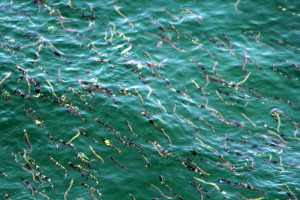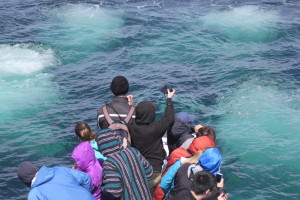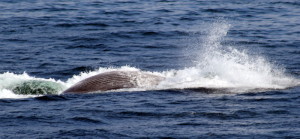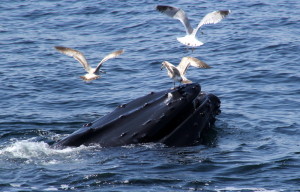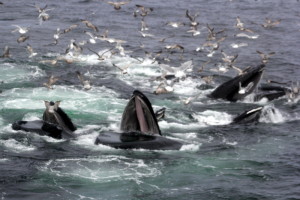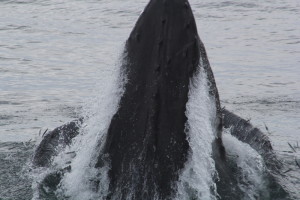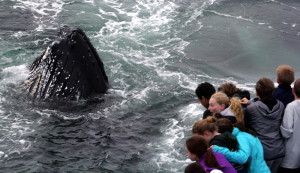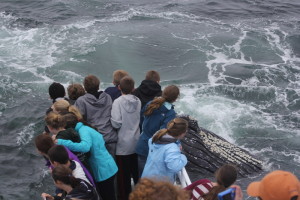Naturalist’s Notebook: May 16 to May 22
* The flood of feeding humpback whales on Stellwagen Bank continued on May 16. Pepper was just one of about a dozen humpback whales seen today making her living on sand eels.
* Views were had of a number of different bubble techniques, including the use of very fine bubble nets and the blowing of spirals of bubble columns.
* But the sightings and activity today were not just the feeding humpback whales, there were also a number of finback whales lunge feeding at Wood End, Race Point, and down toward the Race Point Station.
* Even with all of that surface feeding activity going on, the highlight of the day was, for most of the passengers, the breaching humpback whale calf.
* And that feeding continued again on May 17. Today, however, there were more than a dozen and a half feeding humpback whales. Some of them merely blowing bubbles, as yesterday, to corral the sand eels closer together, but others were also kick feeding. That involves raising the flukes above the surface and slamming them down on the surface of the water to create an additional area of confusion.
* In addition to the bubble columns and kick feeding behaviors, the passengers were also sometimes fortunate enough to see the whales feeding on fish close enough to the surface that they emerged from the bubble clouds with their mouths open.
* May 18 was very much about mother and calf pairs. Tornado, Milkweed, Glostick, Nile, and Echo were all seen with thier calves throughout the day. At one point, on of the youngsters was observed coming to the surface and poking its head out of the water before opening its mouth and snapping its jaws shut. Quite possibly, imitating its mother’s feeding behavior.
* And, of course, the feeding continued on, as usual. Today was also about cooperative feeding, as large groups of humpback whales were emerging from the same bubble systems. Sometimes as many as twelve adults would be lunging through a single system/
* On the morning of May 19, the day started off with some beautiful, close looks at the finwhale named Skeg feeding just beneath the surface near the mouth of Cape Cod Bay. Just like the feeding pair of earlier in May, she was lunging beneath the surface, but close enough to it to send up a large wave on the flat seas to mark her progress.
* The feeding was not limited to Race Point, however. On the Southwest corner of Stellwagen Bank, a number of humpback whales were also observed taking their meals.
* If you look to the bottom, right corner of the photo, you can even make out the sand eels that were lucky enough to escape from this humpback’s open mouth. The tiny animals that escaped from the open mouth of the skim-feeding basking shark were too small to be seen from the deck of the boat.
* May 20 saw even more feeding. As the seas layed down in the afternoon, groups of ten humpbacks were seen feeding together. Three calves were also seen in the area. At this point, the calves are still less than six months old. They are still drinking the very thick, rich milk provided by their mothers. Between 35 and 50 percent milkfat, whale milk has the consistency of cottage cheese. The nutrient and caloric content of this milk allows them to grow very rapidly, adding about a hundred pounds to their body weight nearly every day. By their first birthday, the calves will have nearly doubled their body size.
* For the whalewatches of May21, I would like to thank Leah Crowe who was the only naturalist that took a couple minutes to send me a brief report of what was going on out there. The SouthWest Corner was alive with both kick and bubble feeding, just like many of the days this month. Nile and her calf were seen logging, or resting, this afternoon. Whales can’t truly sleep, like we do, because they have to think about every breath they take. So if they shut down their conscious mind (like we do to sleep) they would cease to breath and suffocate. Instead, they rest, allowing one hemisphere of their brain to rest at a time. This means that one side is always alert to the environment around them and keeping them breathing. When humpback whales rest, because they have a thick layer of blubber beneath their skin, they can just float at the surface, looking like logs from a distance.
* These are just a couple of photos that illustrate just how unconcerned the feeding humpback whales were with the presence of whalewatch boats on May 22. There was a group of five humpbacks that continuously worked the spiral of bubble columns, surfacing each time with their mouths open wide, allowing the passengers an excellent look at the baleen. At one point, those in the bowsprit were able to look into the open mouth and down the upper part of one’s throat.
* In the afternoon, Echo’s calf was seen breaching, lobtailing, and flipper-slapping. In adults, these behaviors are all usually associated with communication and grooming, but with calves, they also might be play and exercise.






